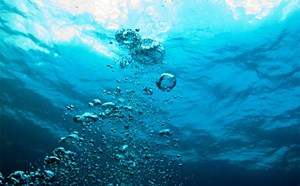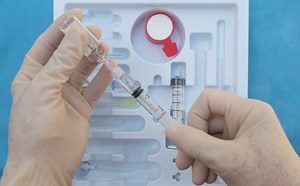
Brain Abscess: A Rare Intracranial Infection in Children
Andrew Shieh, MD
University of Michigan Hospital
Intracranial infections in children are rare and can lead to devastating neurologic outcomes. Focal intracranial infections are diagnosed based on their location: epidural abscess, subdural empyema, and brain abscess. Unfortunately, the symptoms of intraparenchymal infections of the brain are very nonspecific. Early diagnosis combined with prompt initiation of empiric antibiotics and neurosurgical evaluation are important components of care. This article will solely discuss parenchymal brain abscesses.
Brain abscesses are focal parenchymal infections, most often occurring in the first two decades of life.1 Overall, 25% of brain abscesses are seen in children and most often between 4–10 years of age.1 Abscesses begin as regions of cerebritis and progress to suppurative collections of encapsulated pus within 14 days.2 The majority of abscesses occur from direct inoculation of infections including paranasal sinusitis, mastoiditis, dental infections, and otitis media, but also may occur from penetrating skull trauma, surgery (including implantation of ventriculoperitoneal shunts), and hematogenous seeding.1,2,3 A hematogenous source, in association with spread from a distant source including the skin, abdomen, pelvis, heart, and lung, occurs in up to 25% of cases.2,3 No primary source is found in approximately 20-30% of patients.1 Abscess can occur months to years after the precipitating surgery or injury. In children younger than 6 months of age, cyanotic heart disease, intrapulmonary disease with shunt lesions or an associated lung abscess, and immunosuppression are common predisposing factors.4 In the adult population, brain abscesses are also associated with cerebrovascular accidents and human immunodeficiency virus.2,3
It is imperative to highlight that the classic triad of acute headache, fever, and focal neurologic deficit is infrequently seen at presentation.1,2 In neonates, irritability and a bulging fontanelle may be the only symptoms. Visual defects and personality changes in older children can occur as the abscess expands in the parietal or frontal lobes. Dysphasia occurs when an abscess is in the dominant hemisphere. Cerebellar abscesses may cause gait ataxia and abnormal eye movements. More severe neurological symptoms, including altered mental status and focal neurologic deficits, result from intracranial hypertension. Seizures are also a common initial symptom and occur in 30-50% of patients.5 Papilledema on physical examination requires prompt radiological evaluation of the brain.
Neuroimaging is key to diagnosing a possible cerebral abscess. In neonates, ultrasound may be helpful in identifying hypo- or anechoic fluid collections with absent central Doppler flow and peripheral hyperemia surrounding the abscess capsule.6 Cross-table imaging features depend on the progression of the infection. Complete ring enhancement is usually seen during the capsular stage on computed tomography (CT) and demonstrates an abscess that is centrally hypodense with a peripherally ring-enhancing wall surrounded by hypodense vasogenic edema.6 Additionally, CT is usually limited in neonates due to the similar low density of edematous brain during the cerebritis stage and the hypomyelinated brain. Magnetic resonance imaging (MRI) is the preferred imaging modality for diagnosis, even in the emergency department. MRI illustrates a round mass with strong T2-weighted signal with peripheral enhancement and surrounding edema after contrast administration. In addition, the abscess capsule is usually hyperintense on T1-weighted and hypointense on T2-weighted images.6 On diffusion-weighted images, abscesses usually appear hyperintense with centrally restricted diffusion compared to necrotic tumors which appear hypointense on diffusion-weighted images.7
The location of the abscess often reveals the location of the primary source of infection. Ethmoidal or frontal sinusitis results in frontal or temporal lobe abscesses while sphenoid sinusitis results in abscesses in the temporal lobe. 8 Dental infections most commonly cause frontal lobe abscesses. Otitis media and mastoiditis cause abscesses, most commonly in the cerebellum and inferior temporal lobes.8 The frontal lobe is the most common anatomical site, occurring in approximately 38% of cases.1 Multifocal abscesses generally occur from hematogenous spread and are seen in the distribution of the middle cerebral artery where microcirculatory flow at the junction of the gray and white matter is poor.3 Additionally, neonatal abscesses often present with significant edema causing significant mass effect, rapid progression, and invasion of the periventricular white matter. Thus, rupture of abscesses into adjacent ventricles is more often seen in neonates.2
Many different pathogens can cause brain abscesses and the microbial etiology is related to the site of primary infection. A single pathogen can be isolated in 70% of cases, and polymicrobial infections occur in 18% of cases.1,9 Overall, the most common pathogen identified is Streptococci.1,2,10 Peptostreptococcus, Bacteroides, and Streptococcus are usually diagnosed in patients with sinusitis and otitis media.10 Streptococci viridans and Staphlococcus aureus are most often isolated in patients with cardiac disease. Gram-negative rods (Bacteroides, Prevotella, Porphyromonas) and other aerobic gram-positive cocci are seen in patients with prior neurosurgery or head trauma.1 Citrobacter and Proteus, although rare, can be seen in children less than 1 month of age.10 Fungal causes including Candida, Aspergillus, and Cryptococcus are most common in immunocompromised children.
After the diagnosis of brain abscess is determined by imaging, seizure prophylaxis is recommended for all patients with brain abscesses.5 Measures including hyperosmotic therapy and hyperventilation should be taken in the emergency department to control increasing intracranial pressure. Abscess growth can result in rupture into the ventricular system resulting in acute decompensation and meningitis. Corticosteroids are controversial in use to reduce cerebral edema and therapy should be of short duration after consultation with a neurosurgeon. Antiemetics and intravenous pain medication should be given to treat nausea and headache, respectively.
The treatment of brain abscesses requires a multimodality approach, consisting of surgical evacuation, long-term antibiotic treatment, and treatment of another primary infection if present. Typically, patients with cerebritis alone, abscesses smaller than 2.5 cm in diameter, multiple small abscesses, or who are poor surgical candidates are treated conservatively.10 Intravenous antibiotics should be started immediately and not be delayed until a culture is obtained. A 3rd or 4th generation cephalosporin with vancomycin and metronidazole are recommended. Operative management serves to reduce intracranial pressure, contain the infection from spreading, obtain culture for microbiological testing, and improve efficacy of antimicrobial therapy. The decision for stereotactic aspiration or excision should be made by a pediatric neurosurgeon. Antimicrobial therapy should be adjusted by a pediatric infectious disease specialist if a specific pathogen and susceptibilities are identified. Abscesses that are managed operatively typically require antibiotics for 4–6 weeks, while those treated medically require antibiotics for 6–8 weeks.10 A delayed diagnosis of over 1 week, Glasgow Coma Scale below 8 on presentation, immunodeficiency, and presence of underlying diseases including cyanotic heart disease, post-neurosurgery, and immunocompromised state are associated with poor prognosis.9 With improved imaging modalities, surgical techniques, and antibiotic options, mortality has decreased to 4-12% in children and 8-25% overall.6 Complications in survivors include developmental delay, epilepsy, hydrocephalus, and hemianopsia.4
Brain abscess is a severe condition in children that requires aggressive treatment. The diagnosis requires a high index of suspicion in patients who present with headache, fever, and especially with other concomitant infections of structures surrounding the brain.
References
- Roche M, Humphreys H, Smyth E, et al. A twelve-year review of central nervous system bacterial abscesses; presentation and aetiology. Clin Microbiol Infect. 2003;9(8):803-809. doi:10.1046/j.1469-0691.2003.00651.x
- Foerster BR, Thurnher MM, Malani PN, Petrou M, Carets-Zumelzu F, Sundgren PC. Intracranial infections: clinical and imaging characteristics. Acta Radiol. 2007;48(8):875-893. doi:10.1080/02841850701477728
- Brain Abscess. N Engl J Med. 2014;371(18):1756-1758. doi:10.1056/NEJMc1410501
- Goodkin HP, Harper MB, Pomeroy SL. Intracerebral abscess in children: historical trends at Children’s Hospital Boston. Pediatrics. 2004;113(6):1765-1770. doi:10.1542/peds.113.6.1765
- Muzumdar D, Jhawar S, Goel A. Brain abscess: An overview. International Journal of Surgery. 2011;9(2):136-144. doi:10.1016/j.ijsu.2010.11.005
- Nickerson JP, Richner B, Santy K, et al. Neuroimaging of pediatric intracranial infection--part 1: techniques and bacterial infections. J Neuroimaging. 2012;22(2):e42-51. doi:10.1111/j.1552-6569.2011.00700.x
- Haimes AB, Zimmerman RD, Morgello S, et al. MR imaging of brain abscesses. AJR Am J Roentgenol. 1989;152(5):1073-1085. doi:10.2214/ajr.152.5.1073
- Sims L, Lim M, Harsh GR. Review of Brain Abscesses. Operative Techniques in Neurosurgery. 2004;7(4):176-181. doi:10.1053/j.otns.2005.06.002
- Xiao F, Tseng MY, Teng LJ, Tseng HM, Tsai JC. Brain abscess: clinical experience and analysis of prognostic factors. Surg Neurol. 2005;63(5):442-449; discussion 449-450. doi:10.1016/j.surneu.2004.08.093
- 10.Alvis Miranda H, Castellar-Leones SM, Elzain MA, Moscote-Salazar LR. Brain abscess: Current management. J Neurosci Rural Pract. 2013;4(Suppl 1):S67-81. doi:10.4103/0976-3147.116472




